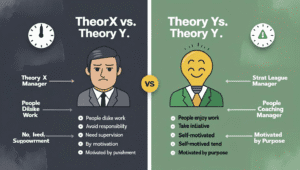Understanding Theory X and Theory Y
A Deep Dive into Douglas McGregor’s Groundbreaking Theories of Workforce Motivation
The Human Side of Enterprise
Theory X
The Authoritarian Approach
Core Assumptions:
The Theory X manager operates from a pessimistic view of human nature. They believe that the average employee is inherently lazy, lacks ambition, and is motivated primarily by extrinsic factors like money and fear of punishment.
- The average person dislikes work and will avoid it if possible.
- Most people must be coerced, controlled, directed, or threatened with punishment to get them to put forth adequate effort.
- The average person prefers to be directed, wishes to avoid responsibility, has relatively little ambition, and wants security above all.
Resulting Management Style:
This mindset leads to a controlling, top-down management style. Decision-making is centralized, and creativity is discouraged. Management relies on strict rules, close supervision, and a system of rewards and punishments to drive performance.
- Micromanagement is common.
- Work is highly structured and non-collaborative.
- Management-employee relationships tend to be adversarial.
- Blame culture is prevalent.
Theory Y
The Participative Approach
Core Assumptions:
The Theory Y manager holds an optimistic view. They believe that people are naturally self-motivated, enjoy the physical and mental effort of work, and will actively seek out responsibility and creative challenges if they are committed to the organization’s goals.
- Effort in work is as natural as play or rest.
- People will exercise self-direction and self-control in the service of objectives to which they are committed.
- Commitment to objectives is a function of the rewards associated with their achievement (including intrinsic rewards like satisfaction).
- The average person learns, under proper conditions, not only to accept but to seek responsibility.
- Creativity and ingenuity are widely distributed among the population.
Resulting Management Style:
This philosophy fosters a collaborative, empowering, and trust-based management style. Decision-making is decentralized, and employees are given autonomy and responsibility. The manager’s role shifts from a controller to a facilitator who removes obstacles and supports their team.
- Emphasis on delegation and employee autonomy.
- Flat organizational structures.
- Collaborative and relationship-focused environment.
- Employees are involved in decision-making.
From Theory to Practice: A Spectrum, Not a Choice
McGregor was clear that Theory X and Theory Y are not two ends of a single continuum. Rather, they are two different, independent sets of assumptions. He was a strong advocate for Theory Y, believing it was a more accurate and effective representation of human potential in the modern workplace. He argued that a Theory X management style often creates a self-fulfilling prophecy: by treating employees as if they are lazy and untrustworthy, managers create an environment where employees act that way.
However, effective management is not about rigidly adhering to one theory. It’s about flexibility. While a Theory Y approach is generally considered more effective for fostering innovation and engagement in knowledge-based work, there may be situations—such as in a crisis, with an inexperienced team, or in highly regulated, repetitive tasks—where a more directive, Theory X-style approach might be necessary temporarily.
The ultimate lesson from McGregor’s work is the power of self-reflection. By understanding their own underlying assumptions about people, leaders can consciously choose to adopt behaviors that unlock their team’s full potential, fostering a culture of trust, responsibility, and intrinsic motivation.
